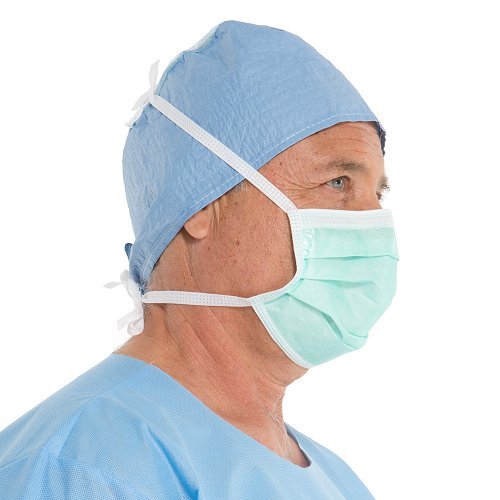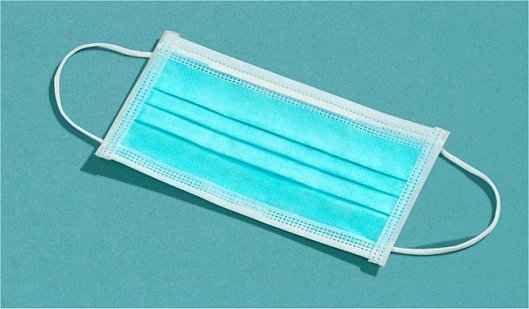Tags
This is Part One of a set of posts called ‘Wearing a Face Mask During a Pandemic’. And it tells you all about Surgical Masks.
Surgical Masks:

Surgical Face masks at a Korean wedding – From Commisceo Global
When you watch TV or social media and see crowds or groups of people from countries which are struggling with Covid-19, many of them will be wearing surgical masks.
Surgical masks are disposable, designed for wearing once only. Most will have a light blue/turquoise outer (waterproof) layer, with 2 further layers in white – the middle layer acts as the filter to large droplets which have traversed the waterproof layer, and the inner layer is the comfort fit for your face which also soaks up any excess moisture.

Medical grade surgical mask fastened with ties
Surgical masks are also recognisable for their pleats. The pleats ensure that the mask is narrow enough to fit the side of the face, while expanding to be wide enough at the centre to cover your face from bridge of nose to under the chin.
Surgical masks are popular because they are light, relatively inexpensive, and usually comfortable to wear.
The combination of materials used in making surgical masks have also been tested to filter out up to 95% of 3.0 Microns size particles (usually classed as Bacteria Filtration), which is extremely helpful in a range of medical settings.
However, those filter calculations were taken by looking at the fabric used, not the way the mask fits.
Surgical masks can fit comfortably on the face and an inbuilt, moldable nose bar makes them a good fit across the nose.

Medical grade surgical mask, showing fit across nose and at sides
However, surgical masks often ‘gap’ at the sides, which means that there is a risk of particles getting into the sides of the mask. With this in mind, a loose fitting surgical mask will not live up to that 95% Bacteria Filtration in a close up situation. It could even slip down as low as 50% maximum. But this will depend upon how the mask fits the individual wearer, because these masks are usually one size fits all.
There is also discussion on the size of virus droplets, as surgical masks are good filters for large (3.0 Microns) bacterial droplets, but not necessarily as good at filtering out micro-sized (0.3 Microns) virus particles which make up part of the Covid-19 viral load.
Research is still ongoing here though, as there is uncertaintly as to the nature of the micro particles in relation to the larger droplets. For example, if most of the micro particles are still part of the larger droplet when they land on the mask, a significant amount of them may be filtered out too – but no one, as yet, knows for sure. However, this makes another article and I’ll leave that one to an expert :).
Nevertheless, surgical masks are excellent at keeping virus particles in.
So, if a Covid-19 sufferer coughs or sneezes while wearing a surgical mask (or even sheds virus particles as they talk), most of these virus particles should remain in the mask, rather than being expelled into the surrounding atmosphere.
Thus the argument goes that if we all wore surgical masks, cross infection would go down dramatically.
This is because there may be many people walking around in public who have Covid-19 but are pre-symptomatic or even asymptomatic, so they look, sound and feel perfectly fine, but may still be shedding the virus. If they had to wear a surgical mask, this could help stop the spread of the virus.
And of course, surgical masks go some way to protect those sharing space with Covid-19 patients, when the patient wears the surgical mask. The mask prevents a significant proportion of virus spread getting out into the surrounding atmosphere.
So surgical masks definitely have their uses. And if we all wore them, along with social distancing and hand washing measures, they would go a long way to keeping us safe.
Wearing of surgical masks by the general public
Several countries encourage the wearing of surgical masks by the population. In Spain, for example, these masks are handed out in public transport stations and even sent to citizens by post.
However, the UK and the US appear to have a serious shortage of surgical masks to be worn by health and social care workers, therefore the Government request is that surgical masks have to be saved for health and social care staff only.
Nevertheless, face masks described as and looking like surgical masks are on sale to the general public, online, and from some local shops, so you may well see many people wearing surgical masks while shopping, working, and travelling on public transport.
How is this possible?

Surgical style face masks which can be purchased online
What often happens is that these masks are made in the same way and with the same materials as the surgical masks used in hospitals. They are said to be tested to the standard of 95% Bacteria Filtration, but have, for example, elastic ear fittings rather than tie head fittings. They may also vary in size to those worn by staff in hospitals.
Some of these masks were originally designed to be used by service workers, such as hairdressers and beauticians, in food preparation, and even in delicate manufacturing processes, and a host of other work situations. But now these masks are being made in their millions to be worn as a form of protection during the pandemic.
And now that the rush by sellers to substantially overprice masks for sale has been largely outlawed, these surgical style masks are quite a reasonable purchase – for example, at time of writing you can purchase a box of 50 for around £10 on eBay or Amazon. So they are still more expensive than they were before the pandemic, but obtainable by many nevertheless, especially to share between friends, family and work colleagues.

Surgical style mask with elastic ear loops for sale online
You may also see some healthcare workers wearing this type of surgical mask, especially in social care, where lack of PPE has left visiting care workers and care home managers having to purchase their own protective wear.
The UK Government’s recommendation is to discourage the wearing of surgical masks by the general public and to encourage the wearing of ‘cloth face covers’ which I’ll discuss more in a later part of this study. But, like other examples of limited Government knowledge, the actual characterisation of what exactly is a surgical mask, compared with the cheaper version purchased online, has left some confusion.
Suffice to say that many of the UK public are wearing these ‘surgical mask’ type face masks and will most probably continue to do so, because they do provide a reasonably effective, recognisable, and relatively comfortable answer to the growing need to wear a face mask.
In the next post, I will be talking about the masks designed to keep us safe as individuals as well as prevent the spread of the virus.
